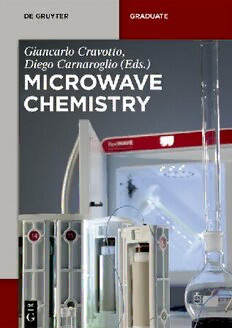
Advances in Green Chemistry: Chemical Syntheses Using Microwave Irradiation (AZREFI Special Publications) PDF
Preview Advances in Green Chemistry: Chemical Syntheses Using Microwave Irradiation (AZREFI Special Publications)
Cravotto,Carnaroglio(Eds.) MicrowaveChemistry DeGruyterGraduate Also of Interest SustainableGreenChemistry. Benvenuto(Ed.);2017 ISBN978-3-11-044189-5,e-ISBN978-3-11-043585-6 MicrowaveandRadio-FrequencyTechnologiesinAgriculture. AnIntroductionforAgriculturalistsandEngineers Brodie,Jacob,Farrell;2016 ISBN978-3-11-045539-7,e-ISBN978-3-11-045540-3 FlowChemistry. Vol.1:Fundamentals;Vol.2:Applications Darvas,Hessel,Dorman(Eds.);2014 ISBN978-3-11-028915-2,e-ISBN978-3-11-028916-9 InorganicMicro-andNanomaterials. SynthesisandCharacterization Dibenedetto,Aresta(Eds.);2013 ISBN978-3-11-030666-8,e-ISBN978-3-11-030687-3 GreenProcessingandSynthesis. Hessel(Editor-in-Chief) ISSN2191-9542,e-ISSN2191-9550 Microwave Chemistry | Edited by Giancarlo Cravotto, Diego Carnaroglio Editors ProfessorGiancarloCravotto UniversityofTurin Dip.diScienzaeTecnologia delFarmaco ViaPetroGiuria9 10125Turin Italy Dr.DiegoCarnaroglio MilstoneSrl ViaFatebenefratelli1/5 24010Sorisole(BG) Italy ISBN978-3-11-047992-8 e-ISBN(PDF)978-3-11-047993-5 e-ISBN(EPUB)978-3-11-048002-3 LibraryofCongressCataloging-in-PublicationData ACIPcatalogrecordforthisbookhasbeenappliedforattheLibraryofCongress. BibliographicinformationpublishedbytheDeutscheNationalbibliothek TheDeutscheNationalbibliothekliststhispublicationintheDeutscheNationalbibliografie; detailedbibliographicdataareavailableontheInternetathttp://dnb.dnb.de. ©2017WalterdeGruyterGmbH,Berlin/Boston Coverimage:MilestoneSrl Typesetting:le-texpublishingservicesGmbH,Leipzig Printingandbinding:CPIBooksGmbH,Leck ♾Printedonacid-freepaper PrintedinGermany www.degruyter.com | Thisbookisdedicatedtomyentireresearchgroup,afantasticteamofresearchers, post-docs,andPhDstudentsfromdifferentcountrieswhosharethesamepassionand enthusiasm. GiancarloCravotto TomyparentsGiovannaandLudovico, towhomIamgratefulforteachingmeaneffectiveworkingmodelthatcombinespro- fessionalismandcompetenceininnovationandglobalbusiness. AndtoGiancarloforhishigh-qualityadvice,support,direction,andpastoralrespon- sibilityduringmyPhDperiodandbeyond. DiegoCarnaroglio Preface The 1940s brought with them the discovery of the heating effects of microwaves which,tento 15yearslater, becameaninnovationthatwasprideofplaceinmany Americankitchens.Atthesametime,microwave(MW) pioneerscarriedoutchemi- calexperiments on polymers and glasses, and generated little more thancuriosity. Inthemid-1980s,however,theMWheatingtechniquewasusedwidelyinchemical experimentationasanewenergysourceanditssalientadvantagesoverconventional heating were well documented. In the initial absence of dedicated MW ovens dur- ing the 1990s, kitchen MW ovens were frequently used by chemists to provide the activationenergy; inthiswayProf. Rajender Varmaexplored a widevariety ofoxi- dation,reduction,cleavage,condensation,multicomponentreactions,combinatorial chemistryandsynthesisofheterocyclesinlessthanthreeminutesundersolvent-free conditions¹ .Despite the inadequatemeasurementof temperaturesinsidethe reac- tion vessels during irradiation,often erroneously described as a ‘magic effect’, the gradualdiffusionofprofessionalmono-andmultimodereactorsfinallyshedlighton the spectacular reaction rate enhancements that the technique can generate. MW- assisted organic synthesis conducted in dedicated MW equipment has now grown intoamaturefieldthathasbeenwidelyadaptedindrugdiscovery,particularlydueto therapidsynthesisofalargenumberof‘lead’compounds,highyields,improvedpu- rityand,frequently,greenerreactionconditions².Althoughreadersaremostfamiliar withthegreatpotentialofdielectricheating,theadvantagesanddisadvantagesofa particular deviceor the conditions needed for maximizingefficiency and function- alitymayperhapsbelessclear.SincethepublicationofVanNoorden’s2008report entitledMicrowavingmyths³,inwhichseveralexpertsdescribedthecurrentstatusof MW-assistedchemistry,newtechnologicaladvanceshavebeenmadethathavebroad- enedboththechemicalapplicationsandscientificinterest;J.Moseley(AstraZeneca) quipped“virtuallyallnewcompoundsnowhavetheirfirstsynthesisinamicrowave” andthisfacthasacquiredevenmorerelevanceyearslater.Thelatestgenerationof lab-scale reactors⁴ are extremely versatile and can accommodate a wide range of reactionconditions.Rapidtechnologicaladvanceshaveenabled faster heatingand cooling,accurateparametermeasurementandcontrol,andawiderrangeofopera- tivepressuresandtemperatures,andthesecoupledwiththeavailabilityofgasinlets and pressurization mean that the technique can now be used in a much broader 1 VarmaRS.Greenchemistry,1999,1(1),43–55. 2 VarmaRS.Advancesingreenchemistry:chemicalsynthesisusingmicrowaveirradiation(2002), AstraZenecaResearchFoundation,Bangalore,India,ISBN:81-901238-5-8. 3 VanNoordenR.Microwavingmyths,Chem.World,2008,5,40. 4 RinaldiL,CarnaroglioD,RotoloL,CravottoG.JAMicrowave-BasedChemicalFactoryintheLab: FromMilligramtoMultigramPreparationsofChemistry2015,ID879531,8pp. https://doi.org/10.1515/9783110479935-201 Preface | VII array of fields: organic and inorganic (nanomaterial) synthesis, plant extraction, biomassdepolymerisationandpollutantdegradationaresomeofthebeneficiaries.⁵ Therapidcoolingoffoncompletionofreactionscanminimizedegradationandside reactions.Furthermore,recentadvanceshavebeenachievedonthe‘kilolab’scaleus- ingacontinuousflowMWsystem,asdescribedbyMorschhauseretal.⁶thatinvolves atransmissionlineshort-circuitedwaveguidereactor,whichcombinesthebenefitsof theexistingmono-andmultimodetechnologies. Anumberofresearchfieldshavetakenadvantageofthefast,molecularlyselec- tiveandvolumetricheatingthatiscreatedbythedirectcouplingofMWenergyand thebulkmixture;aconditionthatoftencannotbereproducedbyclassicalconductive heating.SeveralarticlespublishedintheJournalofChemicalEducation⁷convinceda numberofinstitutionstousethisheatingtooltoreducethetimeofexperimentsinun- dergraduateorganicchemistrylaboratories.Theinitialreportsofexplosionscaused byscientificallymisplaceduseofpressurisedcontainersandTeflon®bombswithsol- vents indomesticMWovensevoked generalconcernover studentsafety,whichre- flectedadverselyonthetechnologyitself.TheuseofdomesticMWovensinchemical laboratoriesisnownotadvisable. Amongotherbenefits,theefficientheattransferandshorterreactiontimesofMW technologyrendersitavaluableassettogreenchemistryconcepts.MWtechnologyal- lowsthereactionstobeperformedonsmallscales:inmilligramsratherthangrams tobeusedinteachinglaboratories,thusreducingthecostofreagentsandchemicals andtheassociatedwastedisposal,whilealsomultiplyingthecreativityofmoreeffi- cientstudents.AlthoughMWtechnologiesarenowusedineveryfacetofchemistry, fromthedissolutionofsamplesforlaboratoryanalysistolarge-scalepreparationsof high-valuefinechemicalsandevenlarger-scaleprocessingofceramicproducts,itis quitedifficulttofinddedicatedundergraduatecoursesonthesubject,withsomerelief duringadvancedPhDresearchactivities. DespitethepublicationofanumberofexcellentbooksonMWchemistryandpro- cessing,thereisalackofsuitabletextbooksthataddresstheneedsofMSandPhDstu- dents,whoneedreadyaccesstotherelevantknowledgetohelpthemappropriately designandcarryoutnewexperimentsunderdielectricheating.Althoughnumerous otheractivationmethodsandtechnologiesareaccessibleforconductingachemical 5 TagliapietraS,CravottoG,CalcioGaudinoE,VisentinS,MussiV,Functionalizationofsingle-walled CarbonNanotubesviathe1,3-CycloadditionofCarbonylylidesunderMicrowaveIrradiation,Synlett, 2012,1459–1462. 6 MorschhauserR,KrullM,KayserC,BoberskiC,BierbaumR,PuschnerPA,GlasnovTN,KappeCO. Microwave-assistedcontinuousflowsynthesisonindustrialscale,GreenProcessSynth.1,2012,281– 290. 7 ParquetE,LinQ,MicrowaveAssistedWolff-Kischner-ReductionReaction,J.Chem.Educ.,1997,74 (10),1225;CresswellSL,HaswellSJ,Microwaveovens–outofthekitchen,J.Chem.Educ.,2001,78 (7),900;ColemanWF,Microwave-assistedheterocyclicchemistry,J.Chem.Educ.,2006,83(4),621. VIII | Preface reaction,itishardtoimagineachemicalresearchlaboratorywithoutaMWreactor likeatypicalhouseholdkitchen. Wesincerelyhopethatthistextbookwillcontributetoencouraginganewgener- ationofchemiststoexploittheMWheatingtechniqueasacommontoolintheirre- searchendeavours.Alltheeminentauthorsofthechaptersinthistextbookarestead- fastMWusersthatdeservemyheartfeltthanksforbeingwillingtotakethetimeand energytocontributetheirwealthofknowledgeinwritingtheirchapters. AfterseveralyearsoffascinatinginvestigationsintotheuseofMW-assistedchem- ical processes and beyond, I would like to highlight my own personal pleasure in coeditingthisbookwithanexpertthatwasonceoneofmymostsuccessfuleverPhD students.Wewouldalsoliketoacknowledgethreeentrepreneursthathavemadea remarkablecontributiontothesuccessofMWchemistrybygarneringexcellentrepu- tationsworldwidefortheirrespectivecompanies;Ihadthehonourofpersonallymeet- ingWernerLautenschläger,FrancoVisinoniandMikeCollins. Prof.GiancarloCravotto DirectoroftheDepartmentof DrugScienceandTechnology (UniversityofTurin–Italy) Contents Preface|VI GiancarloCravottoandPedroCintas 1 Microwavechemistry:history,developmentandlegacy|1 1.1 Introduction|1 1.2 Howitallbegan|1 1.3 Fromcookingtochemistry|3 1.4 Thethermalconundrum|5 1.4.1 Thesearchforspecificeffects:alongjourney|6 1.5 Efficientandfine-tunedheating:theroleofoutliers|11 1.5.1 ConveyingMWenergy:susceptors|11 1.5.2 Apeculiardevice:coolingwhileheating|12 1.6 Efficientbydesign:tailor-madereactors|13 1.7 Conclusions|14 PaoloVeronesi 2 AnIntroductiontodielectricheating|18 2.1 Theelectromagneticspectrumandtheindustrial,scientific,andmedical frequencies|18 2.2 Basisofdielectricheating|19 2.2.1 Selectivity|24 2.2.2 Self-regulatingreactions|26 2.2.3 Volumetricheating|26 2.2.4 Inversionoftemperatureprofile|27 2.2.5 Rapidheating|28 2.2.6 Thermalrunaway|28 CristinaLeonelli 3 Microwavegenerators,transmission,andinteractionwithdifferent materials|31 3.1 Introduction|31 3.2 Microwavegenerators|33 3.2.1 Magnetron|33 3.2.2 Solid-stategenerators|34 3.2.3 Othermicrowavesources|35 3.3 WavePropagation|36 3.3.1 Waveguidemodes|36 3.4 Antennas|38
